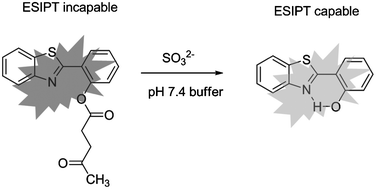A highly sulfite-selective ratiometric fluorescent probe based on ESIPT†
Abstract
The levulinate ester of

* Corresponding authors
a College of Chemistry & Chemical Engineering, Central South University, 932 Lushan South Road, Changsha, Hunan Province, P. R. China
b Key Laboratory of Resource Chemistry of Nonferrous Metals, Ministry of Education, 932 Lushan South Road, Changsha, Hunan Province, P. R. China
c
State Key Laboratory for Powder Metallurgy, 932 Lushan South Road, Changsha, Hunan Province, P. R. China
E-mail:
xzsong@csu.edu.cn
Fax: +86-731-88836954
Tel: +86-731-88836954
The levulinate ester of

 Please wait while we load your content...
Something went wrong. Try again?
Please wait while we load your content...
Something went wrong. Try again?
S. Chen, P. Hou, J. Wang and X. Song, RSC Adv., 2012, 2, 10869 DOI: 10.1039/C2RA21471G
To request permission to reproduce material from this article, please go to the Copyright Clearance Center request page.
If you are an author contributing to an RSC publication, you do not need to request permission provided correct acknowledgement is given.
If you are the author of this article, you do not need to request permission to reproduce figures and diagrams provided correct acknowledgement is given. If you want to reproduce the whole article in a third-party publication (excluding your thesis/dissertation for which permission is not required) please go to the Copyright Clearance Center request page.
Read more about how to correctly acknowledge RSC content.
 Fetching data from CrossRef.
Fetching data from CrossRef.
This may take some time to load.
Loading related content
